Prologue
I would like to set the stage for my reflections by comparing two—widely known—statements on dramatic cinema and the everyday. The first, made by Alfred Hitchcock, urges that film must always comprise drama: “Life with the dull bits cut out”“Drama is life with the dull bits cut out.” Alfred Hitchcock, in François Truffaut, Hitchcock, (New York: Simon & Schuster, 1985), p. 101.—this would be what the cinema audience wants. Henri Lefèbvre, however, writes that “everyday life, in a sense residual, [is] defined by ‘what is left over.’”Henri Lefèbvre, Critique of Everyday Life Vol. 1 (London: Verso, 1991), p. 97. Accordingly, it would seem that the everyday consists of precisely those “dull bits” that have no business appearing in film, at least in narrative film.
Hitchcock’s films are, to be sure, set in life, and therefore within the human and humanly probable, the perceptible and the recognizable—reduced, though they are, to the eventful. Whatever lies between is empty not of occurrence, but of significance for the narrative. When Lefèbvre compares “everyday time to the plain, or to the marshes,”Ibid., p. 87. these places become metaphors for that which expands without structure, that which appears to contradict the filmic. The plain and the swamp cannot be cut; they are an endless underneath or all around that one shouldn’t expect to escape with any momentum. The everyday is the realm of the insignificant repetitions, the dregs of life. It consists of activities that are, to begin with, characterized by necessity and habit before they can be called joyful, aggravating, thrilling, or boring.
This incompatibility between the everyday and cinema finds a certain affirmation when considering the minor role mainstream narrative cinema allots to the everyday. As will be shown in the following, the everyday is indeed relevant to particular genres and is, above all, a topic handled in a cinema beyond Hollywood. The everyday provokes an aesthetics that to some extent turns what Hitchcock deems dramatic on its head. As these everyday patterns unfold, they gradually spell out a potential for narrative and conflict that is contingent less on discrete events than on structures. Two aspects become apparent when looking at such films: the reflection and critique of contemporary forms of life, on the one hand, and on the other, the special ability of cinema to materialize, to make visible and tangible, the “fiber” out of which these forms of life are woven.
Studies on the Everyday
Such films find their counterpart in texts that deal with the everyday, although they hardly ever explicitly refer to film, instead considering cinema a constituent part of practices of everyday life. Lefèbvre’s writings are an example of the interest that everyday life held for the social sciences and humanities, but also for the arts, throughout the twentieth century. As the habitual, as the private which is still more or less identical for everyone, as that which interconnects individuals and makes them a multitude, a mass (members of a culture, a class), the everyday prompts us to examine its generic character, just like it provokes the opposite: the latent, the peculiar. In Freud’s work the everyday can appear as the concealed, the uncanny (“The Uncanny”Sigmund Freud, “The Uncanny,” in The Standard Edition of the Complete Psychological Works of Sigmund Freud, Vol. 17 (London: Hogarth Press, 1955), pp. 218–253.) or as the superficially meaningless whose inconspicuous-seeming distortions imply intense underlying motivations and intentions (“Psychopathology of Everyday Life”Sigmund Freud, “Psychopathology of Everyday Life,” in The Basic Writings of Sigmund Freud, trans. and ed. Dr. A. A. Brill (New York: Random House, 1995), pp. 3–148.). According to Kracauer, the everyday discloses the private’s deformation and adaptation to the public, the fusion of domination and the dominated.Siegfried Kracauer, The Mass Ornament: Weimar Essays, trans. and ed. Thomas Y. Levin (Cambridge, Mass: Harvard University Press, 1995); idem., The Salaried Masses: Duty and Distraction in Weimar Germany (London: Verso, 1998). It is in mindless everyday appearances that the Surrealists sought disruption, the incoherent and incomprehensible and its subversive power, and liberation from sense. For anthropology, the everyday is an object of research and therefore falls under the non-self-evident, the as-yet encrypted and enigmatic. This applies just as much to foreign cultures as to our own.I will name two authors here as representative examples: Marjorie L. DeVault, Feeding the Family: The Social Organization of Caring as Gendered Work (Chicago: University of Chicago Press, 1991), and Daniel Miller (ed.), Unwrapping Christmas (Oxford: Oxford University Press, 1994); idem., A Theory of Shopping (Ithaca, NY: Cornell University Press, 1998). The historiography of the Annales School focuses on evidence and manifestations of the marginal, privileging the consistently recurrent as the substratum and soil of the historical event.The following work is named here only representatively: Fernand Braudel, The Mediterranean and the Mediterranean World in the Age of Philip II, trans. Sîan Reynolds (Berkeley and Los Angeles: University of California Press, 1996). In British mass-observation of the 1930s and 40s, the gaze directed at the mass’s existence coalesces with the Surrealists’ interest in the isolated and sporadically incomprehensible, which both encrypts deeper meanings and can amount to nothing more than the senseless.Cf. Humphrey Jennings and Charles Madge (eds.), May the Twelfth: Mass-Observation Day-Survey (London and Boston: Faber & Faber, 1987); Charles Madge and Tom Harrisson (eds.), Britain by Mass-Observation (London: Ebury Press, 1986). This merely cursory list could be continued—of particular noteworthiness would be studies on the modernization of everyday life in France by Lefèbvre and De Certeau, for example, as well as Cultural Studies’ anti-elitist notion of culture, which is geared to commonplace and popular manifestations of the cultural. These approaches to the phenomenon of the everyday unfold in two different modalities: either through first-hand, more or less systematic observations and interpretations, or through empirical studies, case studies, or long-term observation.
Lefèbvre views the everyday as the total of all lived experience of the ordinary, the recurrent: daily routes, tasks, work, and commuting to the workplace as well as vacation, funerals, the weekly visit to the cinema or dance hall, “hobbies,” family visits, and so on. That which he names as “what is left over” does not constitute a definition; first and foremost, it instead negatively describes everything that does not count in life as special or unique. However, while scanning his list of everyday activities, it becomes clear that it is socially and culturally determined repetitions that are at issue here, rather than biological cycles and the fulfillment of regular bodily needs. This applies to other authors who thematize the everyday, too: when Pierre Mayol dedicates his attention to “bread and wine,” it isn’t to examine the ingestion of nourishment, but rather to observe the complex meaning that these two necessary companions to every meal in France hold within the milieu he investigates.Pierre Mayol, “Bread and Wine,” in Michel De Certeau, Luce Girard, and Pierre Mayol, The Practice of Everyday Life, Volume 2: Living and Cooking (Minneapolis: University of Minnesota Press, 1998), pp. 85–100. On a related note, it is also quite interesting to consider Baudrillard’s remarks on modern interior decoration and furnishings and their emphasis on “communication.” Cf. Jean Baudrillard, “Structures of Interior Design,” in The System of Objects (London: Verso, 2008), pp. 13–29. Lefèbvre forcefully opposes the indifference toward, if not the plain debasement of, the everyday and its alleged degradation at the hands of philosophy and the humanities: “People who gather flowers and nothing but flowers tend to look upon soil as something dirty.” He repeatedly emphasizes the hidden richness of the everyday, whose analysis and critique he sees as the only possibility to overcome alienation. His decidedly political approach seeks insights of reality-oriented relevance within examinations of the everyday:
Thus the simplest event – a woman buying a pound of sugar, for example – must be analyzed. Knowledge will grasp whatever is hidden within it. To understand this simple event, it is not enough merely to describe it; research will disclose a tangle of reasons and causes, of essences and “spheres”: the woman’s life, her biography, her job, her family, her class, her budget, her eating habits, how she uses money, her opinions and her ideas, the state of the market, etc. [. . .] So now I see the humble events of everyday life as having two sides: a little, individual, chance event – and at the same time an infinitely complex social event, richer than the many ‘essences’ it contains within itself.Ibid.
That the critique of the everyday needn’t necessarily forge such a sociologically-oriented path is shown by Roland Barthe’s Mythologies,Roland Barthes, Mythologies (London: Vintage, 1993).] wherein, although he makes reference to Lefèbvre, he penetrates the surface of everyday phenomena interpretively in a semiotic and ideology-critical mode.
Film
In answer to the question of the role of the everyday in narrative film, the preceding cursory excursion into texts on everyday life reveals first and foremost that the “boring moments” need not remain insignificant. These writings turn our gaze to the potentially fascinating aspects of the everyday, for it is in these that social and cultural mindscapes condense and translate into living practices. They manifest in the world of objects, in sequences of events that play out over time, and in the concrete manipulation of given parameters through durations and spaces. The depiction of everyday activities can by far exceed the meaningfulness of the sensational, because the latter’s shape and character is at least equal in vagueness to the former. Numerous differentiations are artificial, and depend on shifts in perspective that often fail to materialize. For the couple who marries, the wedding, one of many attended in the course of one’s life, has to be extraordinary and highly unique. An exam is supposed to be of pivotal importance for one’s future life, even though it counts as merely one among countless exams that one is obliged to take and that nevertheless ultimately prove nothing. The assessment of the everyday, however, is more graspable, since it has clearer reference points; happiness or unhappiness only really becomes manifest in the everyday.
A brief look into film history shows that the everyday becomes relevant primarily when viewed through two perspectives: firstly, as a counter-world in genres portraying the spectacular, such as the horror film, and secondly, in films whose subject is the everyday itself, films that carve conflicts out of everyday life step by step. With a director like Yasujiro Ozu, this can assume both dramaticCf. Tokyo Monogatari (Tokyo Story), jp (1953), with Chishu Ryu, Chieko Higashiyama, Setsuko Hara; or Kohayagawa-ke no aki (The End of Summer), jp (1961), with Ganjiro Nakamura, Setsuko Hara, Yoko Tsukasa. and sereneCf. Bakushu (Early Summer), jp (1951), with Setsuko Hara, Chishu Ryu, Chikage Awashima; or Akibiyori (Late Autumn), jp (1960), with Setsuko Hara, Yoko Tsukasa, Mariko Okada. forms; it could be a comedy like those of Jacques Tati,E.g. Les vacances de M. Hulot, fr (1953), with Jacques Tati, Nathalie Pascaud; or Mon oncle, f (1958), with Jacques Tati, Jean-Pierre Zola, Adrienne Servantie or a psychothriller by PolanskiCf. Repulsion, uk (1965), with Catherine Deneuve, Ian Henry; or Le locataire, fr (1976), with Isabelle Adjani, Melvyn Douglas.; or melodramatic qualities can be emphasized, like with Fassbinder.Angst essen Seele auf (Ali: Fear Eats the Soul), frg (1974), with Brigitte Mira, El Hedi ben Salem, Barbara Valentin. The everyday can likewise be deployed as a medium of the passage of time and of change; here it operates like a kind of catalyst for inner- and intra-subjective processes.See, for example, Ozu’s Banshun (Late Spring), jp (1949), with Setsuko Hara, Chishu Ryu; also Ohayo (Good Morning), jp (1959), with Keiji Sada, Yoshiko Kuga, Chishu Ryu; Zhang Yimou’s Wo de fu qin mu qin (The Road Home) cn (1999), with Zhang Ziyi, Sun Honglei, Zheng Hao; or Wong Kar-Wei’s Fa yeung nin wa (In the Mood for Love), hk (2000), with Maggie Cheung, Tony Leung. The motif of the everyday as a narrative focal point yields no categorization, but instead leads to groupings of films that vary greatly in kind. It furthermore enables the development of relationships and cross-connections among materials that are very heterogenous in terms of their history and style.
Out of a multiplicity of possibilities for setting my focus, here I have opted for examples that concentrate on a critique of postwar Western everyday life in the twentieth century. I will analyze two auteur films from different film-historical phases and relate them to one another: Safe by Todd HaynesSafe, us (1995), with Julianne Moore, Xander Berkeley, Peter Friedman. and Why Does Herr R. Run Amok? by Rainer Werner Fassbinder and Michael Fengler.Warum läuft Herr R. Amok? (Why Does Herr R. Run Amok?) frg (1970), with Kurt Raab, Lilith Ungerer, Irm Hermann, Peer Raben. Both films place the everyday, beyond genre classifications, at the center of the plot and mise en scène. They indeed share traits with horror films to the extent that they forego explicit articulations of the negative sides of modern everyday life, instead portraying these indirectly so that events in the story appear mystifying and inexplicable.
The Everyday as Filmic Object
The 1995 film Safe by Todd Haynes is set in the suburbs, whose supposed harmlessness has been cited time and again in cinema as a mask that conceals evil.Safe takes place in a prosperous part of the San Fernando Valley in Los Angeles. Laura Christian also sees in Safe a latent reference to horror film, although this is much more pronounced in Todd Haynes’ Poison (us, 1991): “Much more flagrantly campy than Safe in its redeployment of the horror genre, Poison’s ‘horror’ allegorizes popular homophobic discourses on AIDS.” Laura Christian, “Of Housewives and Saints: Abjection, Transgression, and Impossible Mourning in Poison and Safe,” Camera Obscura, Nr. 57 (2004): pp. 93–123, here p. 112f. Here, rather than the everyday appearing as the soil from which flowers sprout, it seems a cause of aberration. Since the dysfunctions that manifest go unexplained, and since the film underlines the normality of the apparent, only one conclusion can be drawn: precisely therein must lie the cause, even if it isn’t identified as such. Our main character is a housewife with the indicative name of Carol White. She goes about daily life while her husband practices his profession and a Mexican housekeeper performs the housework. Her duties consist in executing lesser transactions—going to the fitness studio, to the hair salon, buying home furnishings and decorations, accompanying her husband to social functions, and compliantly enduring the sex. Increasingly, she develops symptoms of a heterogenous nature that are classified as allergies: shortness of breath, skin rashes, dizzy spells, nosebleeds. As no causes can be detected, she resorts to the esoteric to explain her ailments, finally retreating to a New-Age institute that attempts to heal people who are “allergic to the twentieth century.” When this fails to produce results, she isolates herself in an igloo-like porcelain bunker on the periphery of the therapy center, and it appears that only time will tell whether she may even die in the near future.
The most striking about this film are the surfaces, all generally sleek and invulnerable, untouchable. We are continuously in transit, driving the car through faceless urban areas, combing equally faceless places—nature never appears as an environment in its own right.


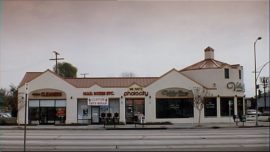
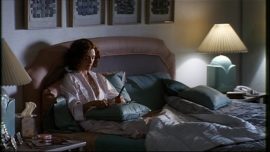
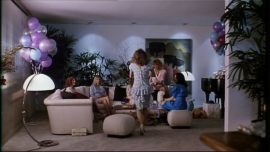
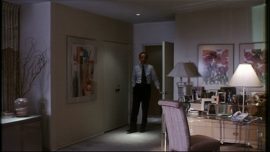
Most fascinating are the interiors: veritable billows of pastel colors in shades of turquoise, violet, and pink. The film is set in 1987, and these colors triumphantly announce the overthrow of the previous decade’s brownish-orange palette. Everything is serene, but cool, complemented by creme-colored backgrounds, wall-to-wall drapery, bright custom-designed kitchens, generously proportioned sofas. The impersonal quality is reminiscent of the elegance-simulations offered by three-star hotels, also of the cheap grandeur of furniture displays in department stores. When Carol, terrified, cries “Oh my God,” directing her gaze off-screen at something hidden from the viewer, we suspect something serious—but the sofa has simply been delivered in the wrong color: black, even though teal is the color she ordered.
Carol is overridingly framed in wide shots, surrounded by copious furnishings such that she seems more an additional object than an inhabitant. The camera captures her in stillness, preferably in frontally oriented shots. The scenes of her “reactions” are characterized by suppression and eruption. The protagonist is affected unexpectedly and holds still, frozen in the situation without responding to the attack in any way. She has a seizure in the arms of her husband where, after she begins to shake, she moves somewhat away from him, but only in the last moment, right before she vomits. Another attack happens at a baby shower while a child is sitting in her lap. Here too she remains motionless; the staging emphasizes the confrontation with the other guests.
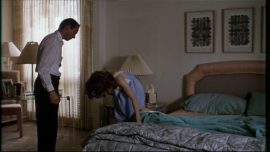
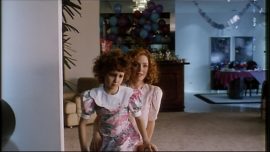
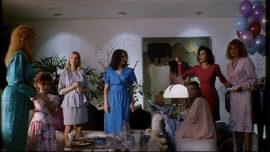
Both incidents take place in moments of affection and bodily closeness, and they take the appearance of aggressive affronts, as if the protagonist were only able to adapt to her surroundings as long as nobody comes too close. In both scenes the camera slowly dollies toward her, but an unbroken distance is maintained. Even though it ‘gives her air,’ she reacts with panic. In the end, Carol could only be under the effects of the apricot-colored atmosphere that saturates the room.Laura Christian and Susan Potter also see, albeit with somewhat different emphases, the components of the filmic space as bearing the key to understanding Carol’s sickness: “Insisting on the fundamental links between the social and the psychic, the symbolic and the corporeal, Safe maps these relations in topographical terms through an examination of discursive construction of ‘safe’ and ‘unsafe’ spaces. [. . .] Though the spaces through which [Carol] moves are extravagant and expansive, they evoke an atmosphere of claustrophobia rather than of luxury or freedom.” Ibid., p. 107. “Declining to distinguish between the causes and effects of Carol’s illness in other than spatial terms, Safe never identifies conclusively any industrial or chemical origin for her malady. [. . .] Our understanding of Carol’s illness is advanced by the way in which the film repeatedly presents us with open but opaque spaces. Frontal and centered camera positions, together with perfect 180-degree reverse shots, present utterly legible spaces initially sustaining the illusion that they can be known and understood by being seen in their totality. Yet these spaces are often excessiveley deep, the exaggerated lines of perspective finally calling attention to their illusory function and highlighting the reverse, the flatness or two-dimensionality of an image that refuses to yield further significance or meaning. [. . .] As should now be apparent, all of Carol’s symptoms are configured as crises of space.” Susan Potter, “Dangerous Spaces: Safe” Camera Obscura, Nr. 57 (2004): pp. 125–154, here p. 134f.
The staging strategies expose the problem: Carol White’s everyday life lacks an outside. There exists only a ubiquitous inside.The absence of any outside is highlighted all the more by rare scenes in which the outside world is revealed. Just as Carol ignores her Mexican employee, she asks her stepson, who has written an essay about gangs in Los Angeles, why it all has to be so “gory.” The omnipresent comfort cushioning everything, the drapery softening the light, the car that provides movement throughout the world—it all promises the ultimate security.Susan Potter takes a similar view, citing “Carol’s daily negotiations of space in her own suburb and further afield in the environs of Los Angeles, where she is always moving from one location to another without ever encountering the outside.” Ibid., p. 127. Carol is cocooned and protected, yet she is assimilated into this inner vacuum: a form of life where one’s choice of sofa color is a substitute for personality, requires no subjectivity, and hence cannot have an alienating effect. Before long, Carol will leave this upholstered environment, withdraw to her own house into a modest chamber with exclusively “natural” furnishings, and continue to retreat deeper and deeper into a stark refugium.
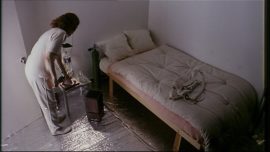
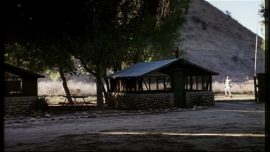
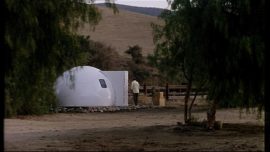
Safe shows that post-industrial society’s consciousness of nature and the environment does not represent a renunciation of a life preceived as “wrong,” that it instead simply expedites it, pressing onward. Carol White never enters the unknown outside. Instead she merely relocates her uneventful everyday to increasingly safer zones, all of this taking place on the level of the material and the bodily: the body, which needs to be shielded from detrimental influences, supplants the self. Overstrained as such, it becomes a manifestation of voiceless unhappiness.
Next I would like to compare the critique of affluence formulated in Safe, which refers to the end of the twentieth century and to social conditions in urban California, with a West German film from an earlier chapter in film history. In Why Does Herr R. Run Amok? by Rainer Werner Fassbinder and Michael Fengler, Herr R./Raab is an unobtrusive minor company employee, married with one child, whose life follows its usual course until finally he abruptly bludgeons his wife, a neighbor, and his child to death with a heavy candlestick. While Safe revolves around a woman who develops typically female symptoms in response to one particular historically determined configuration of everyday life, symptoms that hark back to hysteria and wreak havok on the individual, Herr R.’s killing spree shows, on the surface, a classically male behavioral pattern—outwardly aimed aggression. The answer to the question of why Herr R. eventually fatally clubs his family and the neighbor remains just as vague as the root cause of Carol White’s sickness in Safe. Although their gender-specific conflicts and reaction patterns as well as their historical and societal settings are dissimilar, in principle the subject matters of both films are comparable: they investigate everyday life in a middle-class family where the main character progressively loses him or herself and, feeling excluded from any and all opportunities to communicate, ultimately defends him or herself in a more or less catastrophic and, for everyone else, incomprehensible way. All differences in production conditions aside, both are auteur films strongly characterized by the collectives and cooperative networks in which the directors worked. Rather unusual for Fassbinder’s working style, Why Does Herr R. Run Amok? has no screenplay, only a rough framework of parameters for each scene from which dialogue and camerawork spontaneously evolved.
Why Does Herr R. Run Amok? consists of a series of scenes for which equivalents can be found in Safe,Common to both scenarios are the togetherness of the couples, loath to function properly in both cases, a dinner scene with the child, dinner with the boss (in Safe, dinner with the customers), the main character socializing with coworkers (in Safe, with friends), a visit to the doctor, a jinxed shopping trip. and yet the two film’s structures are disparate—in fact, they could hardly be more incongruous. In Safe the characters are defined through the geometry of the rooms they inhabit, and a motionless camera isolates Carol White from a distance. Why does Herr R. Run Amok?, however, is composed of a constantly wandering hand camera that moves in close proximity to the protagonists. Acting as a counterpoint to scenes where Herr Raab is repeatedly excluded and loses his place in the image, other shots come extremely close to him, though we are still unable to uncover any hints as to his state of mind.The same is true for Carol White in Safe: “Her minimalist presence, like the mute decor in which she lives, is profoundly ambiguous in its affect. The longer we catch her in these (medium) close-ups, the more the camera invites us to scan her face and body for signs of emotion and inner thoughts, the less we know about her.” Roddey Reid, “Unsafe at Any Distance: Todd Haynes’ Visual Culture of Health and Risk,” Film Quarterly Nr. 51 (1998): pp. 32–44, here p. 34.
The film consists solely of everyday scenes in the life of Herr Raab in the office and at home. The vacuous surface glosses over an array of problems, such as the boss’s accusations and a long-awaited promotion that falls through, or the son’s bad grades in school.
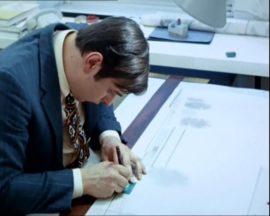
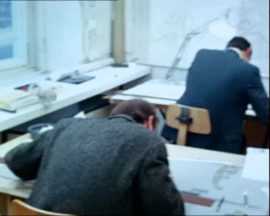
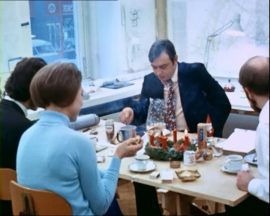
And nevertheless, although it is a far cry from the lush US-American affluence showcased in Safe—the situation here is representative of a good standard of living in late-1960s West Germany. Raab has everything the good life entails: a nuclear family, a car, a television, a color-coordinated furniture suite, blue with a touch of white and the occasional red-orange accent, topped off by accessories in wood and brass, which signalizes solidity. While in Safe the perfected interior says “feel secure and in good hands,” the Raab family ambiance is dimensioned more along the lines of up-to-date middle-class refinement and manifest purchasing power: “money and taste are in adequate supply here,” is its statement.
The film’s restless hand camera implies much, including stillstand, for the camera movements lead to nothing. As a rule, the camera holds its position in spaces prescribed by the furniture, jumps from one protagonist to another, zooms excessively, seldom makes longer paths, and of course never leaves the room.The only exceptions to this are the murder scene and the last scene, which shows the police who are investigating the killing rampage in Raab’s office. This creates a claustrophobic atmosphere and directs our attention at the protagonists. It simultaneously makes a documentary gesture, as if a truth that we’d expect to emerge from the intérieur, the faces, and the improvised dialogue ought to be captured. Since no such truth exists, since the characters are monotonous open books, a feeling of the senseless marking of time is amplified.
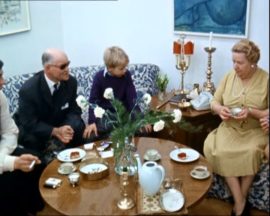
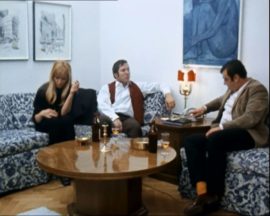
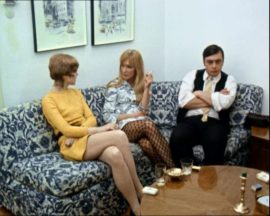
One cannot but notice how the Raab family’s living room is limited to one view, namely, of the sofa arrangement. Similar to the decoration in a television series, half of the room appears to be missing, emphasizing the ceaseless confrontation between the viewer’s gaze and the exhibited protagonists. The room doesn’t become whole until the murder scene, which starts with the familiar picture—Herr Raab, his wife, and a neighbor are sitting next to one another; the neighbor is prattling out an endless monologue made of stock phrases on the topic of skiing, as Frau Raab listens with interest and Herr Raab struggles to focus on watching television. When he stands to adjust the television, we see the opposite wall for the first time. Suddenly, on the other side of the room, we see a space bereft of any fashionable veneer, a space that instead exudes a dull air of pettiness. The naked TV antenna, the brownish, ill-assorted furniture—it all radiates a somewhat shabby, white-bread character. After Raab brings the chitchat on skiing to an end by bludgeoning his wife and the neighbor, the camera leaves the living room for the first time, shifts to the dismal vestibule, to the adjoining rooms, and then delineates another tour of the living room. The sofa corner, which until now has given the impression of being a coulisse, suddenly becomes part of an actual apartment. Ultimately, the sofa remains in the shot, finally empty. The tv is off, and it’s quiet.
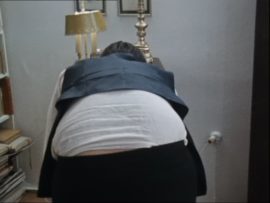
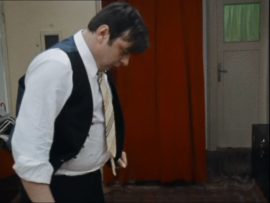
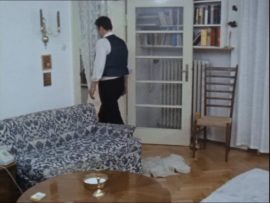
Raab’s violent outburst essentially represents two aspects: his appropriation of the space, and the forcible acquisition of silence. Until now, the staging had unfailingly assigned him a position in his living room exactly like that of a visitor; not once did he comport himself like the master of the house. Just as Carol White, when she describes herself as a “homemaker,” draws no self-affirmation whatsoever from the comfort of the furnishings, Raab too never seems to come into his own as the one who produces this middle-class affluence through his own salary. His captivity by social demands, illustrated by his status as visitor in his own apartment, is ruptured by this act of violence. At the same time, he finally gains control over the background noise that surrounds him. The other characters’ endless, nondescript conversations, in which he seldom participates, mainly function to signal presence and hinder him from turning away. The isolated moments when he “has the floor” misfire due to his inarticulateness, producing only embarrassment or awkward silences.When Herr Raab describes a song he is searching for in a record shop, the saleswomen mockingly laugh at him; when he holds a speech at a company dinner, the other guests feel embarrassed; and when he sings the song lyrics “Wohin soll ich mich wenden . . .” (where should I turn) to his old schoolmate, everyone averts their gazes self-consciously. This inability to articulate oneself is a distinguishing feature in Safe as well: “Carol’s speech in general has a disturbingly hollow quality. Her conversations with mother, husband, and maid are painfully rote. Dialogue in Safe is spare and riddled with drawn-out silences.” Laura Christian, “Of Housewives and Saints,” p. 106. This silence ensues as a latently aggressive reaction to his speaking. Once and for all, he produces the silence through his own aggression—as if it had been silence that was demanded of him all along, a silence he was incapable of achieving.
Both in Safe as in Why Does Herr R. Run Amok?, the problems are explained solely through an analysis of the staging of the everyday. They reveal the surface of a certain form of life whose self-declared meaning is filled with the absence of the unpleasant, on both material and interpersonal levels. The overdrawn staging unveils the unreal side of this everyday life, which virtually pulls the rug out from under the protagonists’ feet.
These analyses show how cinema can contribute a distinct perspective on the subject of everyday life, which I would like to comment on briefly in closing. The same thing that led from one discourse to another in the example cited at the beginning of this essay—the mere buying of sugar—can be expressed in film in extremely compact forms. The compositional means of film do not simply illustrate. Rather, they permit a vivid representation of the structures that define and control seemingly meaningless actions.
Just as anthropology employs an artificial distance toward the intrinsically familiar as a gesture of knowledge production, film, through precise observation and a staging that deliberately abstains from identification, is capable of allowing us to “recognize,” in the concrete sense of the word, the all too familiar. This process gives rise to a strangeness that draws the moment of the surreal out of its hiding place in the everyday, divesting the everyday of its naturalness and guise of rationality. This alienation produces an intuitive understanding for the depicted, whose details, when encountered in real everyday life, elude our perception.
Translation from the German: William Wheeler